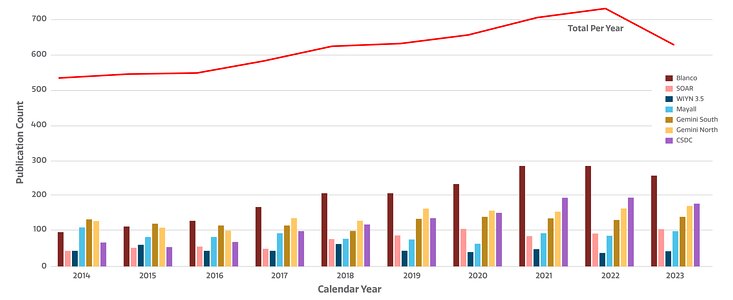NOIRLab Positioned Amongst Top-Ranking Institutions for Scientific Output in 2023
NOIRLab’s world-class telescopes and vast data archive help astronomers around the world conduct and publish their science
7 August 2024
The annual number of publications in peer-reviewed journals using observations from telescopes operated by NOIRLab [1] is among the most important productivity metrics in astronomy, astrophysics and all of science. NSF NOIRLab, which encompasses many of the world’s most powerful and productive telescopes, continues to provide exceptional service to the international astronomical community, leading to impressive representation in peer-reviewed publications.
Since 2014 the observatories comprising NOIRLab have seen an overall increasing trend in total publications [2], from 535 refereed publications in the 2014 calendar year [2] to 640 refereed publications in 2023, slightly lower than 2022 [3]. This trend positions NOIRLab in the upper echelon of world-class observatories, alongside the European Southern Observatory and the Hubble Space Telescope.
Contributing to the greatest number of total refereed publications in 2023, with 476 (75%), were NOIRLab’s mid-scale observatories (MSO). This metric includes telescopes at NSF Kitt Peak National Observatory (KPNO) and NSF Cerro Tololo Inter-American Observatory (CTIO) (both Programs of NOIRLab). A major fraction of these, with 259 publications (54%), resulted from observations made with the Víctor M. Blanco 4-meter Telescope at CTIO. Additionally, the 4.1-meter Southern Astrophysical Research (SOAR) telescope at CTIO contributed to 101 papers, the Nicholas U. Mayall 4-meter telescope at KPNO contributed to 105 papers and the WIYN 3.5-meter telescope at KPNO contributed to 45 papers. MSO highlights include the SMARTS 1.5-meter Telescope at CTIO aiding in the discovery of a phenomenally rare binary star system that is expected to one day explode as a kilonova and the DOE Lawrence Berkeley National Laboratory Dark Energy Spectroscopic Instrument (DESI), mounted on the Mayall telescope, helping astronomers trace a mass migration of stars into the Andromeda Galaxy.
The International Gemini Observatory, which is supported in part by the U.S. National Science Foundation, recorded 276 refereed publications in 2023, comprising 177 refereed publications from the Gemini North telescope and 136 from the Gemini South telescope (some publications used both telescopes). Among these publications were highly impactful discoveries such as the uncovering of a closely bound duo of energetic quasars as well as the identification of a new Luminous Fast Blue Optical Transient, a powerful but poorly understood type of cosmic explosion. These observations were made under Gemini’s Fast-Turnaround/Queue observing modes and Director’s Discretionary queue programming, respectively.
NOIRLab’s Community Science Data Center (CSDC) contributed to 186 publications in 2023. These papers are based in whole or in part on archival data made available through CSDC’s data products and services, such as NOIRLab’s Astro Data Archive (formerly the NOAO Science Archive) and NOIRLab’s Astro Data Lab science platform. In 2023, CSDC data were fundamental to the creation of the Siena Galaxy Atlas — a detailed catalog of almost 400,000 galaxies in our cosmic neighborhood. The atlas was compiled using data from the DESI Legacy Imaging Surveys, which are provided to the astronomical community via the Astro Data Lab and Astro Data Archive. In the coming years, CSDC will open the doors to more profound discoveries as data continue to come in from the ongoing sky survey being conducted by DESI in an effort to create the largest ever 3D map of the Universe.
Another notable metric is the number of publications that NOIRLab staff astronomers contributed to, which in 2023 totalled 431. This includes refereed and non-refereed publications using NOIRLab telescopes, external telescopes and data, and in some cases both.
All in all, the 2023 numbers highlight NOIRLab’s world-class productivity and dedication to enabling and sharing breakthrough discoveries in astronomy and astrophysics with state-of-the-art ground-based observatories, data products, and services for a diverse and inclusive community.
Notes
[1] Only publications from NOIRLab-operated telescopes are included: Gemini North telescope, Gemini South telescope, SOAR Telescope, Víctor M. Blanco 4-meter Telescope, Nicholas U. Mayall 4-meter Telescope, and WIYN 3.5-meter Telescope. The NOIRLab summits also host almost 70 other telescopes and physics experiments, the results of which are not counted here. Additional metrics for other MSO telescopes can be found here.
[2] Some publications use more than one NOIRLab telescope, for which each telescope receives a publication count. The “Total Per Year” metric corrects for this overlap and does not double-count for publications using more than one NOIRLab telescope. Metrics here are reported for the calendar year rather than fiscal year.
[3] The decrease from 2022 to 2023 is mainly due to a decrease in publications based on Blanco and CSDC data. This can largely be attributed to the completion of both the Dark Energy Survey (DES), conducted with Blanco, and the DESI Legacy Imaging Surveys, serviced by CSDC’s Astro Data Lab. A significant increase in papers coincided with the completion of the surveys, and while the numbers slightly decreased last year, follow-up surveys are now underway.
More information
NSF NOIRLab (U.S. National Science Foundation National Optical-Infrared Astronomy Research Laboratory), the U.S. center for ground-based optical-infrared astronomy, operates the International Gemini Observatory (a facility of NSF, NRC–Canada, ANID–Chile, MCTIC–Brazil, MINCyT–Argentina, and KASI–Republic of Korea), Kitt Peak National Observatory (KPNO), Cerro Tololo Inter-American Observatory (CTIO), the Community Science and Data Center (CSDC), and Vera C. Rubin Observatory (operated in cooperation with the Department of Energy’s SLAC National Accelerator Laboratory). It is managed by the Association of Universities for Research in Astronomy (AURA) under a cooperative agreement with NSF and is headquartered in Tucson, Arizona. The astronomical community is honored to have the opportunity to conduct astronomical research on I’oligam Du’ag (Kitt Peak) in Arizona, on Maunakea in Hawai‘i, and on Cerro Tololo and Cerro Pachón in Chile. We recognize and acknowledge the very significant cultural role and reverence that these sites have to the Tohono O’odham Nation, to the Native Hawaiian community, and to the local communities in Chile, respectively.
Links
Contacts
Sharon Hunt
Librarian
NSF NOIRLab
Email: sharon.hunt@noirlab.edu
Josie Fenske
Jr. Public Information Officer
NSF NOIRLab
Email: josie.fenske@noirlab.edu


